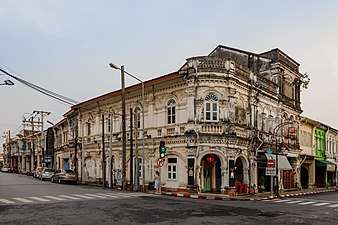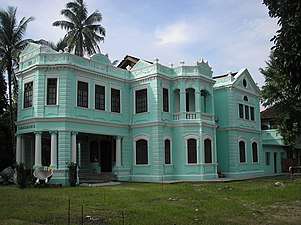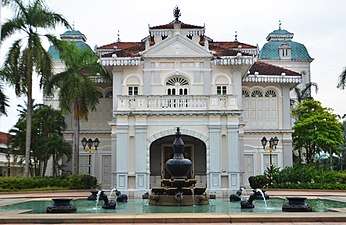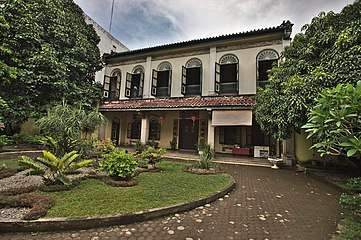Sino-Portuguese architecture
Sino-Portuguese architecture (Chinese: 中葡建築) (Thai: สถาปัตยกรรมจีน-โปรตุเกส or ชิโนโปรตุกีส), also known as Chinese Baroque, Straits eclectic architecture, or simply, Peranakan house is an Asian hybrid style incorporating Chinese and Portuguese architectural styles. It is common in urban centers where Chinese settlers lived in southern China and the Peranakans of the Malay Peninsula, with examples found across present day Peninsular Malaysia (George Town, Penang, Alor Setar, Kuala Terengganu, Kuantan, Ipoh, Kuala Lumpur, Klang, Seremban, Malacca), southern Thailand, Singapore, Macau, Vietnam and Hainan (primarily Haikou).
.jpg)
Sino-Portuguese history in Phuket
The old town in Phuket has a history as the center of a tin mining and trading province. In the era of Western imperialism, after 1511 (2054 BE), Portuguese settlers came to Phuket and to the trade port of Malacca. The settlers brought Western culture with them, as well as science, religion, and their own architectural styles. Portuguese settlers employed Chinese workers to build their houses and establishments. These structures mixed Portuguese and Chinese art styles together, giving rise to Sino-Portuguese architecture.
Sino-Portuguese style
The characteristics of Sino-Portuguese architecture is a mix of European and Chinese styles or simply colonial architecture. These older buildings were built by the Chinese. The building has the design (painting) in Chinese format, but the structure is Portuguese. Typically, the building is a one or two storey mixed commercial-residential building. The wall has strength due to the weight of the tiles on the roof. The roof is clad in curved tiles of Chinese provenance.
Gallery
 Sino-Portuguese architecture, Dibuk Road, Phuket City, Thailand
Sino-Portuguese architecture, Dibuk Road, Phuket City, Thailand Thalang Road townhouses, Phuket City
Thalang Road townhouses, Phuket City.jpg) Phuket Thai Hua School building, Phuket City
Phuket Thai Hua School building, Phuket City.jpg) Arab Street, Singapore, shophouse ornamentation
Arab Street, Singapore, shophouse ornamentation Kuden Mansion in Satun, Thailand, an example of a box layout Sino-Portuguese mansion. The building now houses the Satun National Museum.
Kuden Mansion in Satun, Thailand, an example of a box layout Sino-Portuguese mansion. The building now houses the Satun National Museum.- Governor's Mansion in Phuket City represents a contrast to Kuden Mansion, with a more extensive layout.
 Magazine Road townhouses in George Town, Malaysia
Magazine Road townhouses in George Town, Malaysia Hai Kee Chan, George Town; currently the Pinang Peranakan Mansion, illustrates more basic ornamentation of the style for upper class townhouses.
Hai Kee Chan, George Town; currently the Pinang Peranakan Mansion, illustrates more basic ornamentation of the style for upper class townhouses. Cathay Hotel in George Town (c. 2002), a hotel conversion of the Yeo Wee Gark mansion (also known as The Venus). The Edison George Town boutique hotel has since occupied the building.
Cathay Hotel in George Town (c. 2002), a hotel conversion of the Yeo Wee Gark mansion (also known as The Venus). The Edison George Town boutique hotel has since occupied the building. The Tan Boon Chia mansion in Rasa, Malaysia in 2007, an example of an expansive Straits-styled mansion in the former territories of the Federated Malay States.
The Tan Boon Chia mansion in Rasa, Malaysia in 2007, an example of an expansive Straits-styled mansion in the former territories of the Federated Malay States. Istana Ulu in Kuala Kangsar, Malaysia, incorporates many ornamental elements of mansion designs in the Sino-Portuguese style.
Istana Ulu in Kuala Kangsar, Malaysia, incorporates many ornamental elements of mansion designs in the Sino-Portuguese style..jpg) Facade ornamentation of a Straits-styled townhouse in the old quarter of Malacca City, Malaysia.
Facade ornamentation of a Straits-styled townhouse in the old quarter of Malacca City, Malaysia.- Baba Nyonya Heritage Museum, Chinatown, Malacca City, Malaysia.
- Johor Art Gallery in Johor Bahru, Malaysia, a converted Straits-styled government mansion.
.jpg) Club Street townhouses, Singapore. Some of the buildings incorporate open balconies on the third floor.
Club Street townhouses, Singapore. Some of the buildings incorporate open balconies on the third floor.- Tanjong Pagar Road shophouses, illustrating three-storey varieties of Straits architecture.
 Double storey shophouses at Joo Chiat Lane, a common design in the outer reaches of urban Singapore.
Double storey shophouses at Joo Chiat Lane, a common design in the outer reaches of urban Singapore. Tjong A Fie Mansion, Medan, Indonesia, a rarer example of Sino-Portuguese architecture in the country.
Tjong A Fie Mansion, Medan, Indonesia, a rarer example of Sino-Portuguese architecture in the country.
See also
- Ancestral houses of the Philippines
- Architecture of Kuala Lumpur
- Penang
- Architecture of Singapore
- Bahay na Bato
- Malay houses
- Nipa hut
- Rumah adat
- Shophouse
- Tong lau
External links
- Old Phuket Houses. Retrieved 3 October 2016, form http://www.phuket.com/magazine3/focus.htm?cid=ch:OTH:001
- Phuket's Old Town Movement. Retrieved 3 October 2016, form https://web.archive.org/web/20170222091439/http://lestariheritage.net/phuket/webpages/mov01.html
- 18 AMAZING SINO PORTUGUESE MANSIONS IN OLD PHUKET TOWN. Retrieved 3 October 2016, form
- http://www.phuket101.net/sino-portuguese-mansions-phuket/
- PHUKET TOWN SINO-PORTUGUESE ARCHITECTURE. Retrieved 3 October 2016, form https://www.roughguides.com/destinations/asia/thailand/southern-thailand-andaman-coast/phuket/phuket-town/phuket-town-sino-portuguese-architecture/